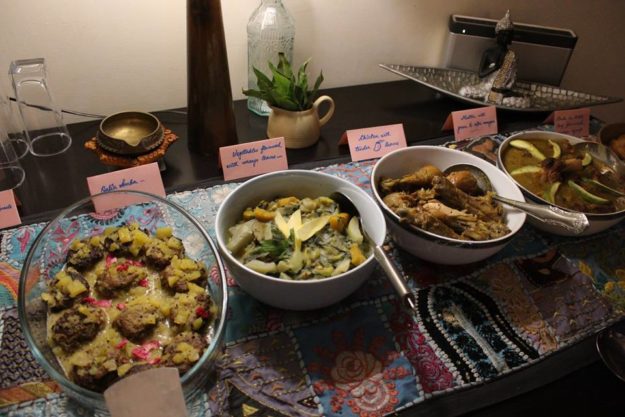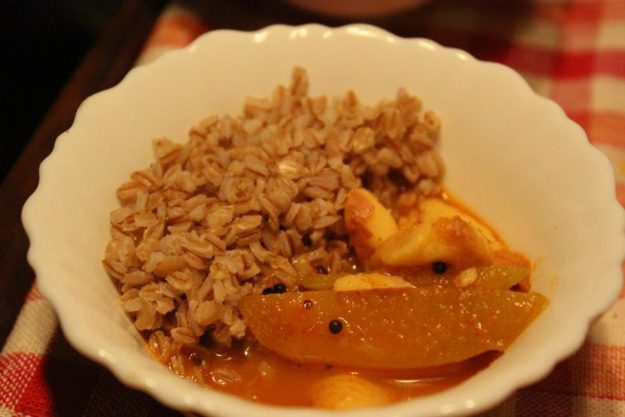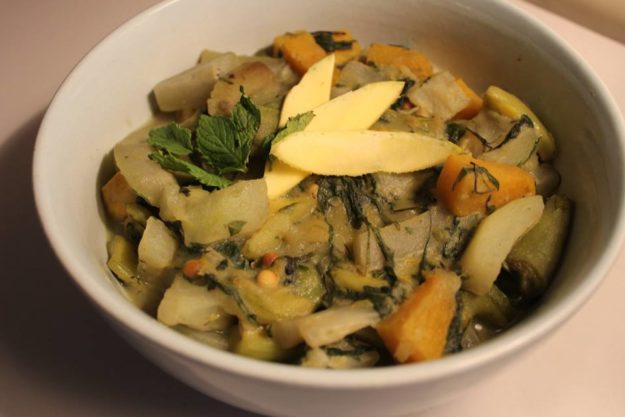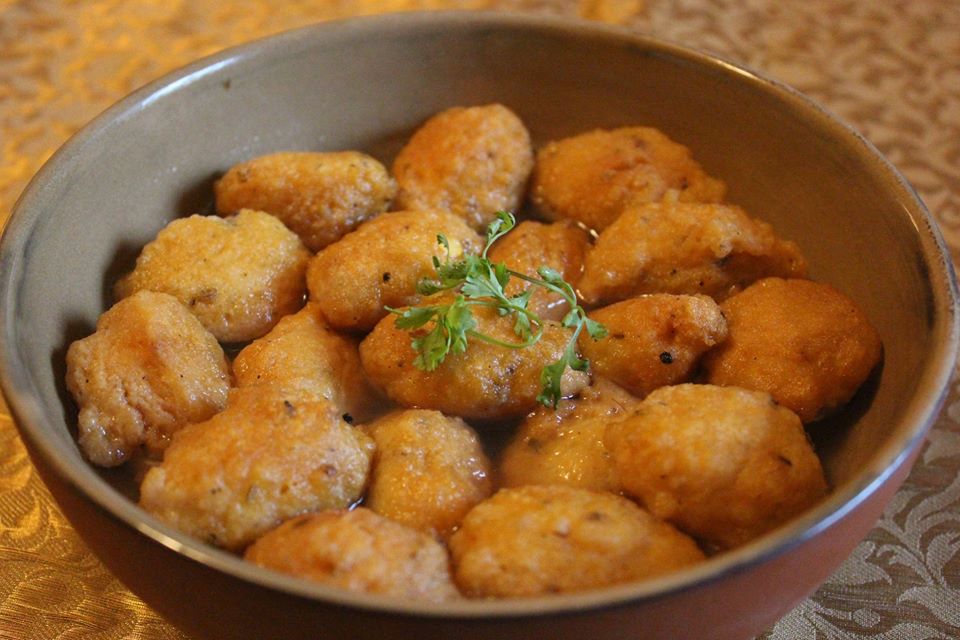ForkTales’ Mango Fest – Medieval Mangoes
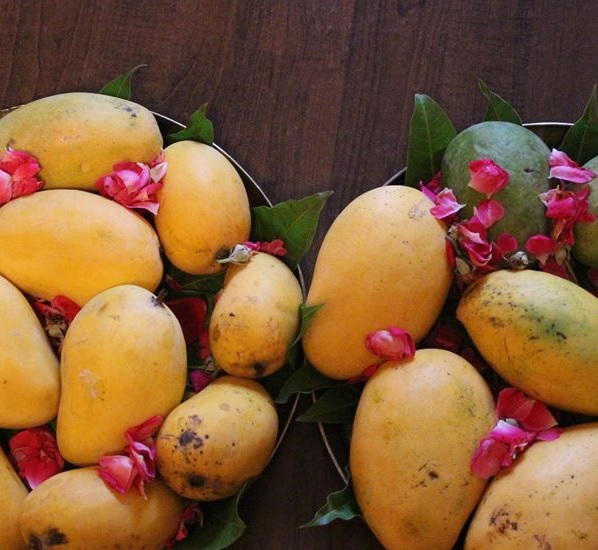
Wading through the often difficult Indian summers, how could Social Tables by ForkTales not find solace in company of the king of fruits that make the subcontinent’s summers worth drudging through! So, there we were celebrating Indian mangoes in their complete glory with basket full of mangoes to taste and a whole spread, from drinks to desserts, that used almost every bit of the mango. Of course, there were stories and tales about origin and history of mangoes.
The earliest mention of mango is in Hindu scriptures dating back to 4000 B.C. It is mentioned in early Vedic literature as Rasala and Sahakara. The Ramayana has mention of mango groves. Brihadaranyaka Upanishad and Varaha Puran prohibit the felling of a mango tree. There is consensus among historians and horticulturists that mangoes and it’s cultivation originated in India in the Assam – Burma region. Scientists of the Birbal Sahni Institute of Palaeibitany, Lucknow, have traced the origin of genus Mangifera from 60 million years old fossil of carbonized mango leaves near Damalgiri, West Garo Hills.
Mangoes became cultivated as early as 2000 B.C. and explorers who tasted the fruit were enarmoured by it and introduced it to other tropical countries. The mango adapted to new places and new varieties evolved.
During 4-5th centuries B.C. the Buddhist monks took mango to Malaya Peninsula and East Asia. Mangoes were introduced in China by Chinese traveler Hwen T‟sang during middle of the 7th Century A.D. In the 10th Century A.D. the Persians carried it to East Africa and in 14th century Moroccan traveler Ibn Battuta reported it at Mogadishu. The Portuguese were the first ones to start mango trade when they landed in Calcutta in 1498.
In ancient India, such was a place of mangoes that rulers used names of favoured varieties to bestow titles upon eminent people. The Mango tree was also associated with the god of love “Manmatha” and its blossoms were considered to be the god‟s arrows by the Hindu Nanda kings. The Buddhists considered the tree sacred as Buddha meditated under a mango tree.
In the medieval period, Alauddin Khilji was the first patron of mangoes and his feast in Sivama Fort was nothing but mangoes in different forms on the lavish menu. The Mughals and their fondness for the mango is legendary, and the only legacy that remained unbroken through the dynasty! It is said that Babur was reluctant to face the warrior Rana Sanga of Mewar, despite Daulat Khan Lodis promises of a good part of his empire and war booty. It is said that Lodi then introduced Babur to mangoes, which convinced him to face Rana Sanga and also lay the foundation of his empire in India. His son Humayun ensures a steady supply of mangoes while on run from India to Kabul. Akbar built the vast Lakhi Bagh near Darbhanga growing over a hundred thousand Mango trees, which is one of the earliest example of grafting mangoes. It was under Akbar that India got the Totapuri, the Rataul and the expensive Kesar.
The 2nd orchard of grafted mangoes was by emperor Jahangir in Lahore, Pakistan and the third at the “Jharna Qutub” village (now known as Shamsi Talab Mehrauli) was commissioned by Shah Jahan. Shah Jahan’s fondness for mangoes was such that he had his son Aurangzeb, the then Wazir of Decean, punished and house arrested because he failed to send him mangoes from his favourite orchard! It was also mangoes that Aurangzeb sent to Shah Abbas of Persia to support him to his fight for the throne.
Mughal khansamahs created the Aam Panna, Aam Ka Lauz and Aam ka Meetha Pulao, a delicate Mango dessert sold all through the summer in the Shahjahanabad. Even Nur Jahan, the empress was rather fond of the Mango drink and used a mix of mangoes and roses to create her legendary wines.
As I read through text after text for reference of mangoes, it struck me that as celebrated as mangoes are from the yore, old recipes with mangoes aren’t easy to come by, barring the ones using the green, unripe ones, or mangoes in desserts. While Ain-i-Akbari and Tujuk-e-Jehangiri has detailed account of mangoes, there are no main course recipes. In the Mughal kitchen till then mangoes were to be eaten on their own.
And then comes the Ni’matnama – The Book of Delicacies – of Sultan Ghiyath Shah (1495-1505) of Mandu in present day Madhya Pradesh! So fond of pleasures of life he was that he brought together miniature style of painting and food, and left behind the Nimatnama. The book is a treasure trove of innovative recipes, that begins with the plea – “King of cockroaches! Please do not eat this, my offering to the culinary world — recipes of cooking food, sweetmeats, fish and the manufacture of rose-water perfumes.”
The King of cockroaches did not completely comply so tiny bits and parts of Ni’matnama is lost to time, but what survives has more than 30 recipes that uses mangoes in their varied forms – dried mango kernels to flavour rice, tender mango leaves to flavoure vegetables and chicken, ripe mangoes in curry, and wadas in digestive mango juice! It also has the most sublime mango desserts and aromatic sherbets that use spices! We picked an entire menu for the evening from Shah’s Ni’matnama. Two dishes that I couldn’t resist adding was the unique green mango kozambhu with bamboo rice which has mention in Tamil Sangam literature and Ghalib’s favourite – Qaliaamba. Afterall, how can one have a mango spread in Delhi and not have the poet’s favourite on the menu!
As a parting note, we just came back from Mandu, seeing the magnificient Jahaz Mahal, another work of art left behind by the Sultan. Jahaz Mahal was his pleasure palace studded with 15,000 women. Apparently, in his later days, when he was no longer the spry goat he had once been, Shah needed the help of his concubines to climb the steep winding staircases in his various abodes. On each step, bare-chested maidens were said to thrust their breasts forward for the old king to hold for support. But let us remember him for his contribution to food!
